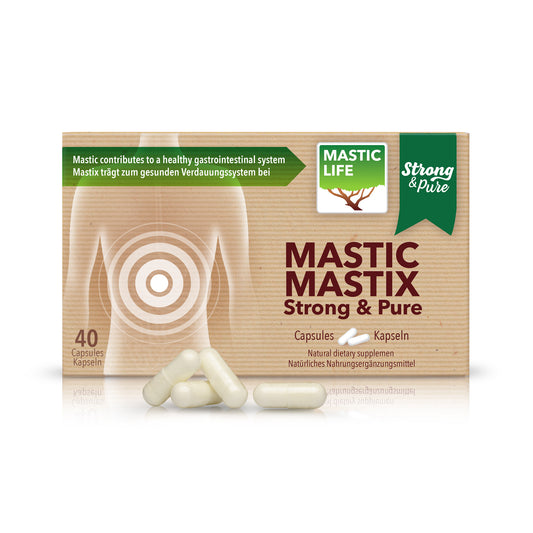Studies: ANTIDIABETIC ACTIVITY OF CHIOS MASTIC
Recent scientific studies suggest that Chios Mastic, a natural resin from the Pistacia lentiscus tree, may help support healthy blood sugar levels and improve metabolic health. Below is a summary of key research findings.
Study Summaries
1. Activation of PPARγ Receptor
Petersen et al. (2011) discovered that oleanonic acid, found in Chios Mastic, activates PPARγ – a receptor involved in glucose and fat regulation. This action may help improve insulin sensitivity and blood sugar levels.
2. Enzyme Inhibition for Blood Sugar Control
Vuorinen et al. (2015) showed that triterpenes in Chios Mastic (like masticadienonic and isomasticadienonic acids) selectively inhibit 11β-HSD1, an enzyme that influences glucose metabolism.
3. Improved Metabolic Markers in Diabetic Mice
Georgiadis et al. (2013) tested Chios Mastic on diabetic mice and observed reduced blood sugar, cholesterol, and triglycerides, especially in low-dose groups. Liver fat accumulation was also improved.
4. Antihyperglycemic Activity in Rats
Saad Ur Rehman et al. (2015) reported that 100 mg/kg of crude Chios Mastic significantly lowered blood sugar in diabetic rats and improved glucose tolerance.
5. Effects on Liver and Inflammation
Tzani et al. (2016) found that in animal models of NAFLD, Chios Mastic lowered glucose, triglycerides and IL-6 levels and reduced liver fat after 4 weeks of supplementation.
6. Long-Term Human Use
Triantafyllou et al. (2006) observed lower glucose levels in men who took Chios Mastic daily for one year, without side effects.
7. Lowering Blood Sugar and Cholesterol in Healthy People
Kartalis et al. (2015) studied 156 healthy volunteers and found that daily intake of Chios Mastic lowered fasting blood glucose and cholesterol, especially in overweight individuals. No adverse effects were reported.
8. Reduced Insulin Resistance in Japanese Men
Fukazawa et al. (2017) found that 5g of Chios Mastic per day reduced triglycerides and insulin resistance after 3–6 months, especially when combined with exercise.
9. Potential PPAR Modulation
Georgiadis et al. (2014) reviewed previous research and concluded that triterpenes in Chios Mastic (like oleanolic and gallic acid) may act as dual PPAR modulators, supporting glucose and fat metabolism.
Important Disclaimer
Chios Mastic is a dietary supplement, not a medication. If you’re considering using it to support blood sugar, cholesterol, or general health, please consult your doctor or healthcare provider first. It may not be suitable for everyone, especially if you have a medical condition or are taking medication.
- Petersen R.K., Christensen K.B., Assimopoulou A.N., Fretté X., Papageorgiou V.P., Kristiansen K., Kouskoumvekaki I. [2011]: Pharmacophore-driven identification of PPARγ agonists from natural sources. J. Comput. Aided Mol. Des., 25 (2): 107-16.
- Vuorinen A., Seibert J., Papageorgiou V.P., Rollinger J.M., Odermatt A., Schuster D., Assimopoulou A.N. [2015]: Pistacia lentiscus oleoresin: Virtual screening and identification of masticadienonic and isomasticadienonic acids as inhibitors of 11β-hydroxysteroid dehydrogenase 1. Planta Med., 81 (6):525- 532.
- Georgiadis I., Karatzas T, Korou L.-M., Agrogiannis G., Vlachos I.S., Pantopoulou A., Tzanetakou I.P., Katsilambros N., Perrea D.N. [2013]: Evaluation of chios mastic gum on lipid and glucose metabolism in diabetic mice. J Med Food, 00 (0): 1–7.
- Saad Ur Rehman M., Hafeez Kamran S., Ahmad M., Akhtar U. [2015]: Anti-diabetic activity of crude Pistacia lentiscus in alloxan-induced diabetes in rats. Bangladesh J of Pharm, 10 (3):543-547.
- Tzani A, Georgiadis, I, Korou LM, Konstantopoulos P, Agrogiannis G, Vlachos I, Doulamis I, Katsilambros N, Perrea D. (2016). Investigation of chios mastic gum effect on metabolic profile in streptozotocin-induced diabetic mice. Atherosclerosis.
- Triantafyllou A, Chaviaras N, Sergentanis TN, Protopapa E, Tsaknis J: Chios mastic gum modulates biochemical parameters in a human population. J Ethnopharmacol 2007; 111: 43-9.
- Kartalis A., Didagelos M., Georgiadis I., Benetos G., Smyrnioudis N., Marmaras H., Voutas P., Zotika C, Garoufalis S., Andrikopoulos G. [2015]: Effects of Chios mastic gum on cholesterol and glucose levels of healthy volunteers: A prospective, randomized, placebo-controlled, pilot study (Chios-Mastic). eur J of Prev Cardiol, epub ahead of print.
- Fukazawa T, Smyrnioudis I, Konishi M, Takahashi M, Ki K Hyeon, Nishimaki M, Xiang M, Sakamoto S. (2018). Effects of Chios mastic gum and exercise on physical characteristics, blood lipid markers, insulin resistance, and hepatic function in healthy Japanese men. Food Science and Biotechnology.
- Georgiadis I., Karatzas T, Korou L.-M., Katsilambros N., Perrea D. [2014]: Beneficial health effects of chios gum mastic and peroxisome proliferator-activated receptors: Indications of common mechanisms. J Med Food, 00 (0): 1–10.
Mastic for your gastrointestinal tract
-
Mastic Strong&Pure (40 Capsules) Masticlife
Regular price 6.500 FtRegular priceUnit price / per -
Mastic Strong&Pure Economy Pack (240 Capsules) Masticlife
Regular price 34.800 FtRegular priceUnit price / per -
Mastic Chios Raw Tears Medium Size 10 g
Regular price From 2.100 FtRegular priceUnit price / per20.200 FtSale price From 2.100 FtSale -
Mastic Chios Raw Tears Medium Size 20 g
Regular price From 4.100 FtRegular priceUnit price / per40.500 FtSale price From 4.100 FtSale




